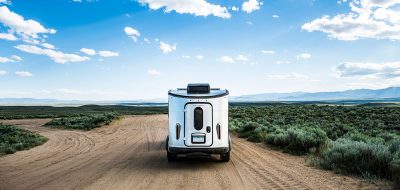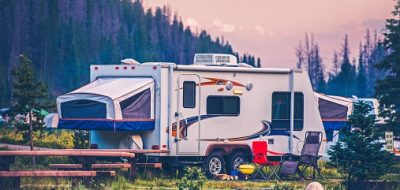While gas prices have dropped recently (in October and November) from the rates we saw earlier this year (in July and August), it still pays to drive efficiently. And, of course, it always pays to drive safely and comfortably. Here are more tips regarding driving, mileage and fuel:
Driving and Mileage
- Keep your gas tank at least one-fourth full at all times. If you’re in an area where gasoline stations are few and far between, try to keep the tank more than half full.
- Always expect road construction when you travel—you won’t be disappointed.
- If you get a flat tire on the road, first of all move out of traffic lanes. Then decide if you will change it yourself, use an emergency road service, or look up a local service or truck service center. Many people with Type C motorhomes or trailers or fifth wheels can change a flat tire themselves as if it were a car tire. If you decide to change the tire yourself, consult the owner’s manual, then see if your vehicle is equipped with the tools you need. If you have an emergency road service plan with an organization such as AAA, Good Sam, or Family Motor Coach Association, you can call the organization for help. Otherwise, search out a local service center. For a heavy RV, you will probably need to find a truck service center.
- On a road with three lanes, consider which lane you want to drive in. By driving in the right-hand lane, you have to watch for traffic on only one side. On the other hand, if you drive in the middle lane, trucks and faster traffic can pass you from the rear on either side.
- Try to keep your last travel day short. If you arrive home by midafternoon, you’ll be able to unload in daylight and do all the necessary tasks when you’re not weary from a long day’s travel.
- If you don’t keep your headlights on all the time, be sure to turn them on when it rains. In many states, you’re required to do so.
- When it’s time to fuel the RV, choose a gas station carefully. Using a gas station on the right side of the street is easier than crossing traffic. Before pulling up to the pump, check to see how the station is laid out. Is the roof over the pumps high enough to clear the fifth wheel or motorhome? Is there enough room to maneuver to and from the gas pumps? Are the entrance and exit level enough that the rear hitch on the motorhome won’t drag on the ground?
- Truck stop stores carry all kinds of merchandise that truckers (or tourists) might need or want—from travel logs to clothes to snacks and souvenirs. And of course the adjoining restaurants usually serve good food because that’s especially important to people making their living on the road.
- Truck stops stay open all night. You can buy a directory there that lists the locations of truck stops across the country or find various online listing sites simply by searching via your favorite search engine.
Enjoy your RVing!
Bernice







A. W. Walker
Gary Mots’ interpretation (above) of the California law is incomplete and misleading. Here is the appropriate section from the State of California Commercial Driver License Handbook which governs RVs that are towing, as well as many commercial trucks:
” Right Lane Rule (Applies if you are Towing)
Vehicles listed in VC §22406 must be driven in the designated lane or lanes when signs are posted. When no signs are posted, these vehicles must be driven in the right-hand traffic lane or as close as possible to the right edge or curb.On a divided highway with four or more traffic lanes in one direction, these vehicles may also be driven in the lane just to the left of the right-hand lane. When overtaking or passing another vehicle going in the same direction, drivers of such vehicles must use either: (1) the designated lane, (2) the lane just to the left of the right-hand lane, or (3) the right-hand traffic lane when such use is permitted. ”
If you are a motorized RV under 26, 000 GVWR or under 40′, and NOT towing, then you can observe this guidance from the California Driver’s Handbook:
“Choosing A Lane
Traffic lanes are often referred to by number. The left or “fast” lane is called the “No. 1 Lane.” The lanes to the right of the No. 1 lane are called the No. 2 lane, then the No. 3 lane. etc. Drive in the lane with the smoothest flow of traffic. If you can choose among three lanes, pick the middle lane for the smoothest driving. To drive faster, pass, or turn left, use the left lane. When you choose to drive slowly or enter or turn off the road, use the right lane. If there are only two lanes in your direction, pick the right lane for the smoothest driving.
Chris
I’d like to point out that if you get a flat tire…. get off the highway entirely.
Just keep driving to the next exit and find a safe place away from all traffic to change the tire. Even if you end up shredding the tire you are still in a better place than beside speeding traffic.
This provides more safety for you, your family or the tech from your autoclub.
Gary Mots
Here in California, if your a truck, (eighteen wheeler) or a vehicle pulling a trailer (including boats, travel trailers, etc) the law is to stay in the right hand lane except to pass. It seems to work for us. Most motor home drivers usually stay in the right hand lane also, except to pass.
If someone is merging onto a freeway or even a three lane road and doesn’t look to the rear to merge, they shouldnt be driving as far as I am concerned. By the time you are in a position to murge onto a roadway you should be at the same speed as the traffic, and usually don’t slow down on the freeway untill your on the off ramp, then start your braking and slowing down.
I know, I know, everybody thinks California drivers are the worst. Just my .02
Becuse this is not a law in most states, I always see 18 wheelers from out of state, especially in the left, or fast lane and generally there is a bottleneck and backed up traffic behind them, also I see this with people pulling trailers, it is vary anoying to me to see drivers not being curtious and thinking about others in stead of themselves .
Places to go
thanks for the information but I believe most of the people already know this (no off ofcourse!)
A. W. Walker
Most of these bullet points are handy to think about, and even the seasoned vets among us can use a review of the basics occasionally. The fourth bullet should be expanded, however. On a three lane road, it is very common that the right lane is used by local traffic for entrance and exit from the road. That means the traffic there tends to be accellerating or decellerating. Sometimes they do it without checking traffic to their rear. Therefore, there is a significant and dangerous speed differential between the right lane and all the other lanes, which tend to be used by through-traffic. I have learned to stay in the second lane over from the right, for just that reason whether it’s the middle lane or not. It also keeps you from getting trapped in a Right-Lane-Exit-Only situation. I can maintain a smoother pace and experience less risk of sudden slow-downs due to decellerating or slowly accellerating traffic in the right lane. Get better fuel economy, too! Since three lanes and more is usually a feature of urban, rather than rural driving, I’d advise that it’s safer and more economical for heavy vehicles to stay in the second lane over from the right, unless you are planning on exiting soon. No kidding.